Business Administration Report: Legal and Operational Aspects
VerifiedAdded on 2021/01/03
|9
|3200
|428
Report
AI Summary
This report provides a comprehensive analysis of business administration, focusing on the management of office facilities, legal requirements, and health and safety protocols within a business context, using ALDI as a case study. It examines the legal obligations related to office management, including data protection and the provision of essential services. The report delves into the establishment of office management procedures, resource management, and techniques for monitoring and managing workflows. It also explores typical support and welfare facilities for office workers. Furthermore, the report addresses the legal responsibilities of employers and employees regarding health and safety, including accident and emergency procedures. It examines meeting procedures, including the purpose, legal implications, accuracy, and content of meeting minutes, along with note-taking techniques. The report also outlines the features, purposes, and facilitation techniques of formal and informal meetings. Additionally, it covers the use of targets and budgets to manage workloads, quality management techniques, and the identification of areas for improvement. Finally, the report explains the characteristics, requirements, and planning of events, along with the information needed before, during, and after an event.
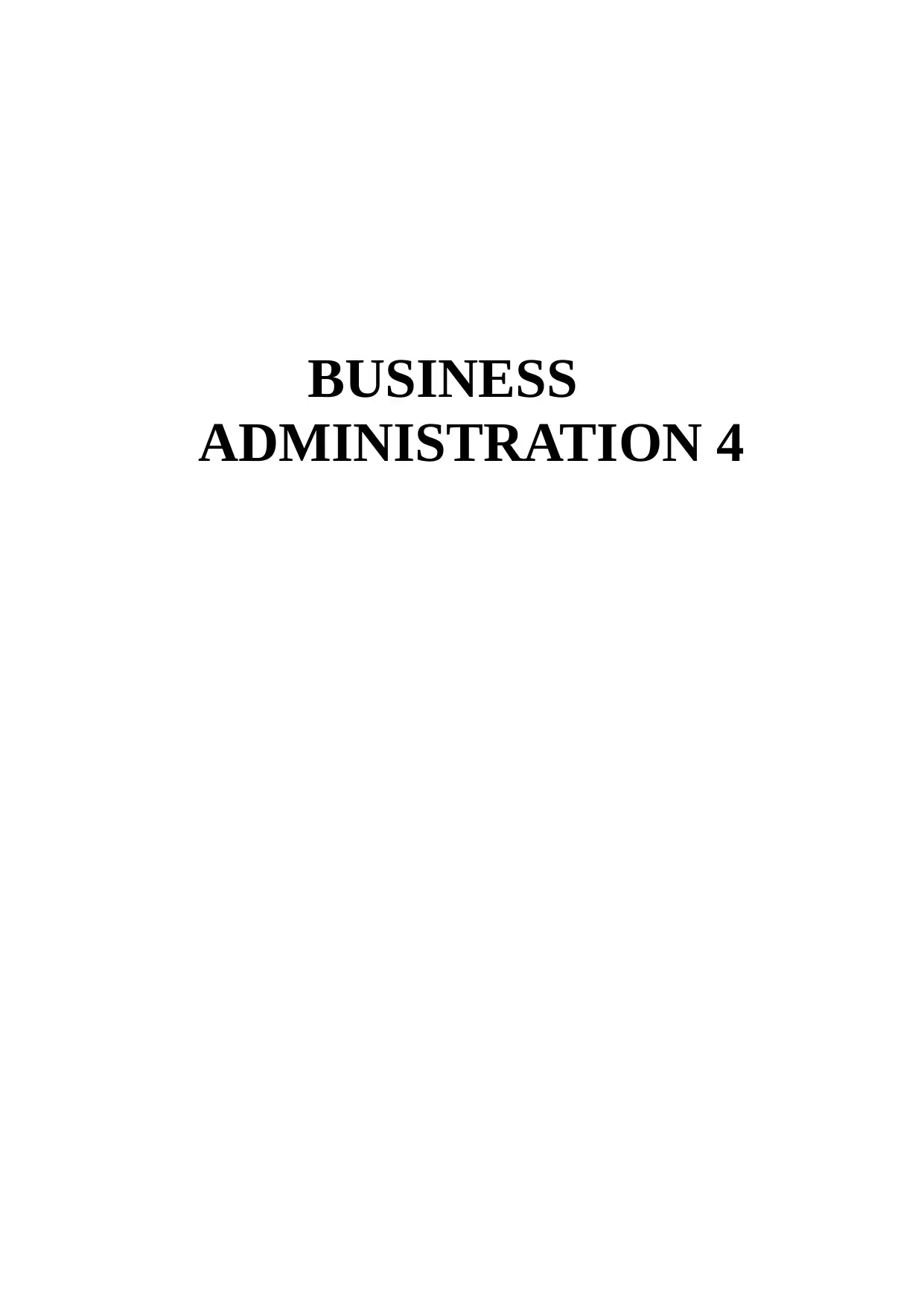
BUSINESS
ADMINISTRATION 4
ADMINISTRATION 4
Paraphrase This Document
Need a fresh take? Get an instant paraphrase of this document with our AI Paraphraser
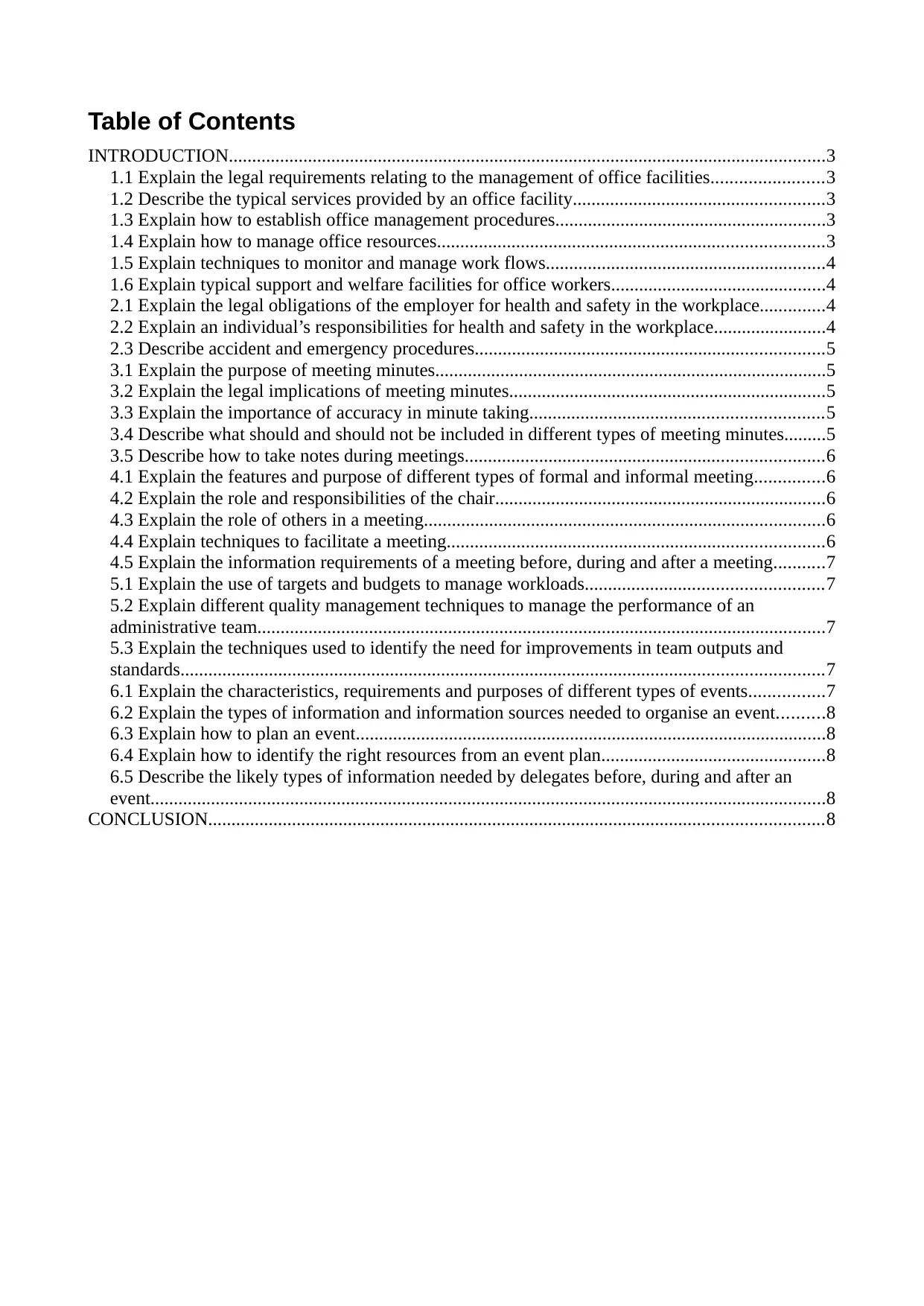
Table of Contents
INTRODUCTION................................................................................................................................3
1.1 Explain the legal requirements relating to the management of office facilities........................3
1.2 Describe the typical services provided by an office facility......................................................3
1.3 Explain how to establish office management procedures..........................................................3
1.4 Explain how to manage office resources...................................................................................3
1.5 Explain techniques to monitor and manage work flows............................................................4
1.6 Explain typical support and welfare facilities for office workers..............................................4
2.1 Explain the legal obligations of the employer for health and safety in the workplace..............4
2.2 Explain an individual’s responsibilities for health and safety in the workplace........................4
2.3 Describe accident and emergency procedures...........................................................................5
3.1 Explain the purpose of meeting minutes....................................................................................5
3.2 Explain the legal implications of meeting minutes....................................................................5
3.3 Explain the importance of accuracy in minute taking...............................................................5
3.4 Describe what should and should not be included in different types of meeting minutes.........5
3.5 Describe how to take notes during meetings.............................................................................6
4.1 Explain the features and purpose of different types of formal and informal meeting...............6
4.2 Explain the role and responsibilities of the chair.......................................................................6
4.3 Explain the role of others in a meeting......................................................................................6
4.4 Explain techniques to facilitate a meeting.................................................................................6
4.5 Explain the information requirements of a meeting before, during and after a meeting...........7
5.1 Explain the use of targets and budgets to manage workloads...................................................7
5.2 Explain different quality management techniques to manage the performance of an
administrative team..........................................................................................................................7
5.3 Explain the techniques used to identify the need for improvements in team outputs and
standards..........................................................................................................................................7
6.1 Explain the characteristics, requirements and purposes of different types of events................7
6.2 Explain the types of information and information sources needed to organise an event..........8
6.3 Explain how to plan an event.....................................................................................................8
6.4 Explain how to identify the right resources from an event plan................................................8
6.5 Describe the likely types of information needed by delegates before, during and after an
event.................................................................................................................................................8
CONCLUSION....................................................................................................................................8
INTRODUCTION................................................................................................................................3
1.1 Explain the legal requirements relating to the management of office facilities........................3
1.2 Describe the typical services provided by an office facility......................................................3
1.3 Explain how to establish office management procedures..........................................................3
1.4 Explain how to manage office resources...................................................................................3
1.5 Explain techniques to monitor and manage work flows............................................................4
1.6 Explain typical support and welfare facilities for office workers..............................................4
2.1 Explain the legal obligations of the employer for health and safety in the workplace..............4
2.2 Explain an individual’s responsibilities for health and safety in the workplace........................4
2.3 Describe accident and emergency procedures...........................................................................5
3.1 Explain the purpose of meeting minutes....................................................................................5
3.2 Explain the legal implications of meeting minutes....................................................................5
3.3 Explain the importance of accuracy in minute taking...............................................................5
3.4 Describe what should and should not be included in different types of meeting minutes.........5
3.5 Describe how to take notes during meetings.............................................................................6
4.1 Explain the features and purpose of different types of formal and informal meeting...............6
4.2 Explain the role and responsibilities of the chair.......................................................................6
4.3 Explain the role of others in a meeting......................................................................................6
4.4 Explain techniques to facilitate a meeting.................................................................................6
4.5 Explain the information requirements of a meeting before, during and after a meeting...........7
5.1 Explain the use of targets and budgets to manage workloads...................................................7
5.2 Explain different quality management techniques to manage the performance of an
administrative team..........................................................................................................................7
5.3 Explain the techniques used to identify the need for improvements in team outputs and
standards..........................................................................................................................................7
6.1 Explain the characteristics, requirements and purposes of different types of events................7
6.2 Explain the types of information and information sources needed to organise an event..........8
6.3 Explain how to plan an event.....................................................................................................8
6.4 Explain how to identify the right resources from an event plan................................................8
6.5 Describe the likely types of information needed by delegates before, during and after an
event.................................................................................................................................................8
CONCLUSION....................................................................................................................................8
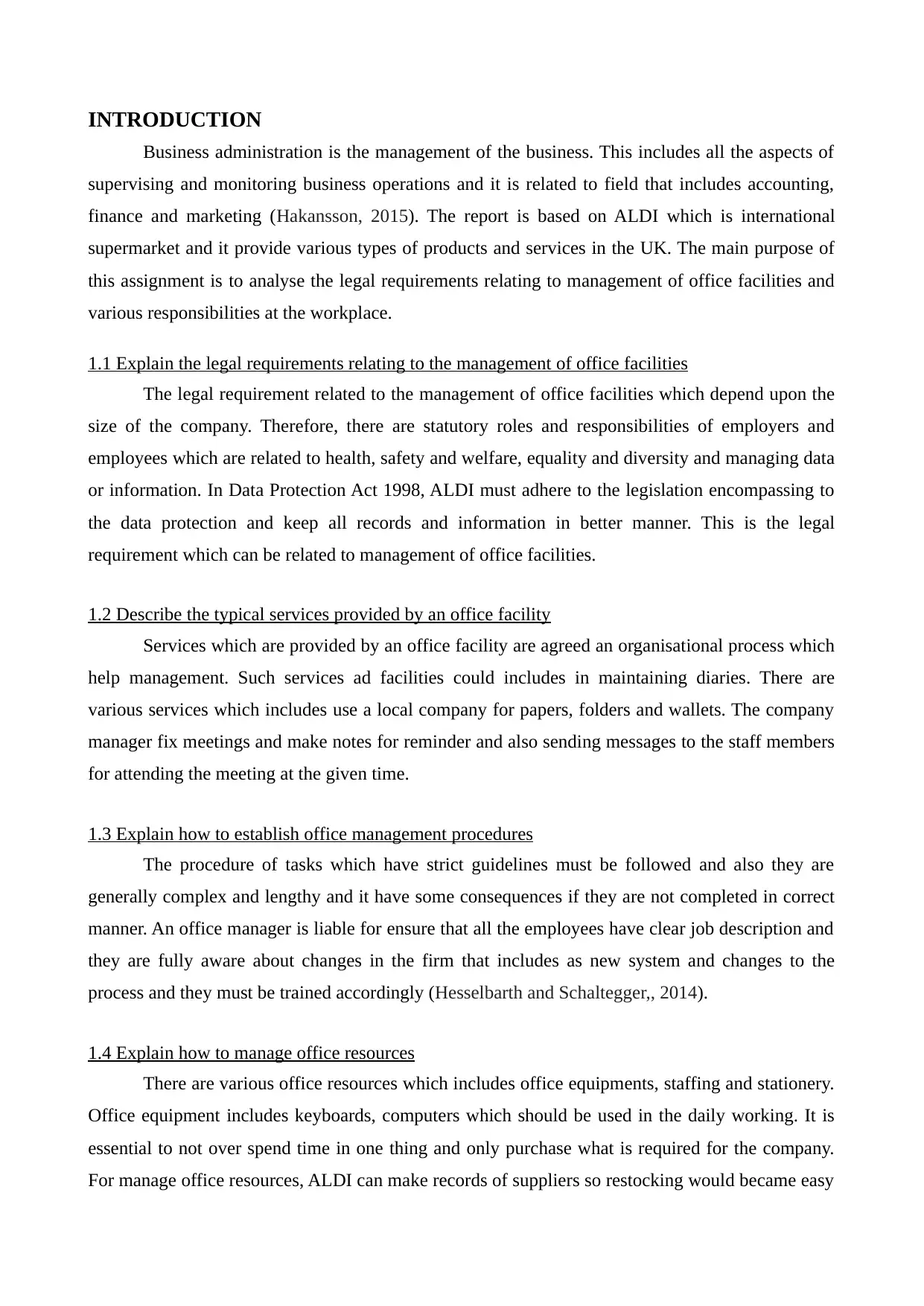
INTRODUCTION
Business administration is the management of the business. This includes all the aspects of
supervising and monitoring business operations and it is related to field that includes accounting,
finance and marketing (Hakansson, 2015). The report is based on ALDI which is international
supermarket and it provide various types of products and services in the UK. The main purpose of
this assignment is to analyse the legal requirements relating to management of office facilities and
various responsibilities at the workplace.
1.1 Explain the legal requirements relating to the management of office facilities
The legal requirement related to the management of office facilities which depend upon the
size of the company. Therefore, there are statutory roles and responsibilities of employers and
employees which are related to health, safety and welfare, equality and diversity and managing data
or information. In Data Protection Act 1998, ALDI must adhere to the legislation encompassing to
the data protection and keep all records and information in better manner. This is the legal
requirement which can be related to management of office facilities.
1.2 Describe the typical services provided by an office facility
Services which are provided by an office facility are agreed an organisational process which
help management. Such services ad facilities could includes in maintaining diaries. There are
various services which includes use a local company for papers, folders and wallets. The company
manager fix meetings and make notes for reminder and also sending messages to the staff members
for attending the meeting at the given time.
1.3 Explain how to establish office management procedures
The procedure of tasks which have strict guidelines must be followed and also they are
generally complex and lengthy and it have some consequences if they are not completed in correct
manner. An office manager is liable for ensure that all the employees have clear job description and
they are fully aware about changes in the firm that includes as new system and changes to the
process and they must be trained accordingly (Hesselbarth and Schaltegger,, 2014).
1.4 Explain how to manage office resources
There are various office resources which includes office equipments, staffing and stationery.
Office equipment includes keyboards, computers which should be used in the daily working. It is
essential to not over spend time in one thing and only purchase what is required for the company.
For manage office resources, ALDI can make records of suppliers so restocking would became easy
Business administration is the management of the business. This includes all the aspects of
supervising and monitoring business operations and it is related to field that includes accounting,
finance and marketing (Hakansson, 2015). The report is based on ALDI which is international
supermarket and it provide various types of products and services in the UK. The main purpose of
this assignment is to analyse the legal requirements relating to management of office facilities and
various responsibilities at the workplace.
1.1 Explain the legal requirements relating to the management of office facilities
The legal requirement related to the management of office facilities which depend upon the
size of the company. Therefore, there are statutory roles and responsibilities of employers and
employees which are related to health, safety and welfare, equality and diversity and managing data
or information. In Data Protection Act 1998, ALDI must adhere to the legislation encompassing to
the data protection and keep all records and information in better manner. This is the legal
requirement which can be related to management of office facilities.
1.2 Describe the typical services provided by an office facility
Services which are provided by an office facility are agreed an organisational process which
help management. Such services ad facilities could includes in maintaining diaries. There are
various services which includes use a local company for papers, folders and wallets. The company
manager fix meetings and make notes for reminder and also sending messages to the staff members
for attending the meeting at the given time.
1.3 Explain how to establish office management procedures
The procedure of tasks which have strict guidelines must be followed and also they are
generally complex and lengthy and it have some consequences if they are not completed in correct
manner. An office manager is liable for ensure that all the employees have clear job description and
they are fully aware about changes in the firm that includes as new system and changes to the
process and they must be trained accordingly (Hesselbarth and Schaltegger,, 2014).
1.4 Explain how to manage office resources
There are various office resources which includes office equipments, staffing and stationery.
Office equipment includes keyboards, computers which should be used in the daily working. It is
essential to not over spend time in one thing and only purchase what is required for the company.
For manage office resources, ALDI can make records of suppliers so restocking would became easy
⊘ This is a preview!⊘
Do you want full access?
Subscribe today to unlock all pages.

Trusted by 1+ million students worldwide
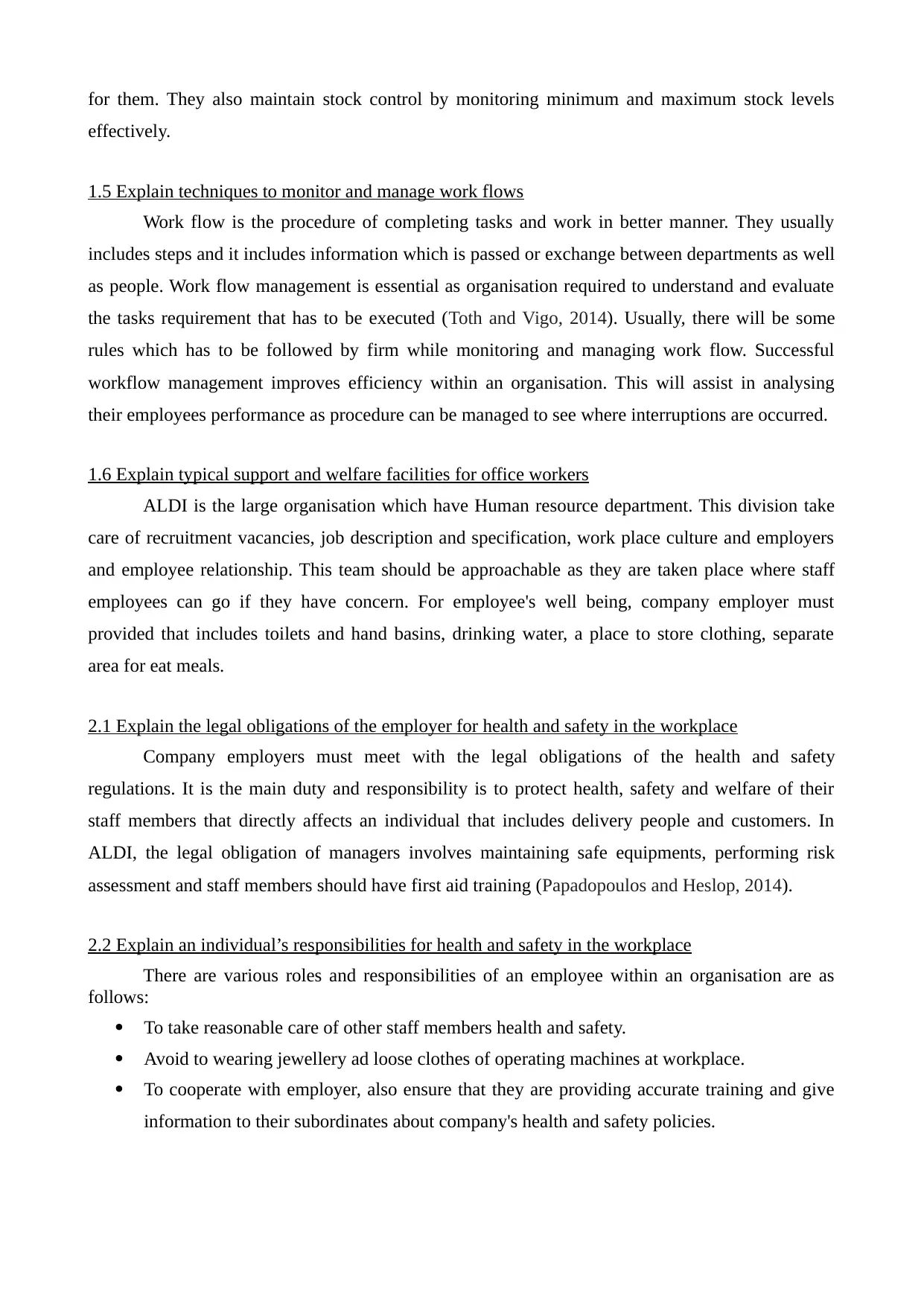
for them. They also maintain stock control by monitoring minimum and maximum stock levels
effectively.
1.5 Explain techniques to monitor and manage work flows
Work flow is the procedure of completing tasks and work in better manner. They usually
includes steps and it includes information which is passed or exchange between departments as well
as people. Work flow management is essential as organisation required to understand and evaluate
the tasks requirement that has to be executed (Toth and Vigo, 2014). Usually, there will be some
rules which has to be followed by firm while monitoring and managing work flow. Successful
workflow management improves efficiency within an organisation. This will assist in analysing
their employees performance as procedure can be managed to see where interruptions are occurred.
1.6 Explain typical support and welfare facilities for office workers
ALDI is the large organisation which have Human resource department. This division take
care of recruitment vacancies, job description and specification, work place culture and employers
and employee relationship. This team should be approachable as they are taken place where staff
employees can go if they have concern. For employee's well being, company employer must
provided that includes toilets and hand basins, drinking water, a place to store clothing, separate
area for eat meals.
2.1 Explain the legal obligations of the employer for health and safety in the workplace
Company employers must meet with the legal obligations of the health and safety
regulations. It is the main duty and responsibility is to protect health, safety and welfare of their
staff members that directly affects an individual that includes delivery people and customers. In
ALDI, the legal obligation of managers involves maintaining safe equipments, performing risk
assessment and staff members should have first aid training (Papadopoulos and Heslop, 2014).
2.2 Explain an individual’s responsibilities for health and safety in the workplace
There are various roles and responsibilities of an employee within an organisation are as
follows:
To take reasonable care of other staff members health and safety.
Avoid to wearing jewellery ad loose clothes of operating machines at workplace.
To cooperate with employer, also ensure that they are providing accurate training and give
information to their subordinates about company's health and safety policies.
effectively.
1.5 Explain techniques to monitor and manage work flows
Work flow is the procedure of completing tasks and work in better manner. They usually
includes steps and it includes information which is passed or exchange between departments as well
as people. Work flow management is essential as organisation required to understand and evaluate
the tasks requirement that has to be executed (Toth and Vigo, 2014). Usually, there will be some
rules which has to be followed by firm while monitoring and managing work flow. Successful
workflow management improves efficiency within an organisation. This will assist in analysing
their employees performance as procedure can be managed to see where interruptions are occurred.
1.6 Explain typical support and welfare facilities for office workers
ALDI is the large organisation which have Human resource department. This division take
care of recruitment vacancies, job description and specification, work place culture and employers
and employee relationship. This team should be approachable as they are taken place where staff
employees can go if they have concern. For employee's well being, company employer must
provided that includes toilets and hand basins, drinking water, a place to store clothing, separate
area for eat meals.
2.1 Explain the legal obligations of the employer for health and safety in the workplace
Company employers must meet with the legal obligations of the health and safety
regulations. It is the main duty and responsibility is to protect health, safety and welfare of their
staff members that directly affects an individual that includes delivery people and customers. In
ALDI, the legal obligation of managers involves maintaining safe equipments, performing risk
assessment and staff members should have first aid training (Papadopoulos and Heslop, 2014).
2.2 Explain an individual’s responsibilities for health and safety in the workplace
There are various roles and responsibilities of an employee within an organisation are as
follows:
To take reasonable care of other staff members health and safety.
Avoid to wearing jewellery ad loose clothes of operating machines at workplace.
To cooperate with employer, also ensure that they are providing accurate training and give
information to their subordinates about company's health and safety policies.
Paraphrase This Document
Need a fresh take? Get an instant paraphrase of this document with our AI Paraphraser
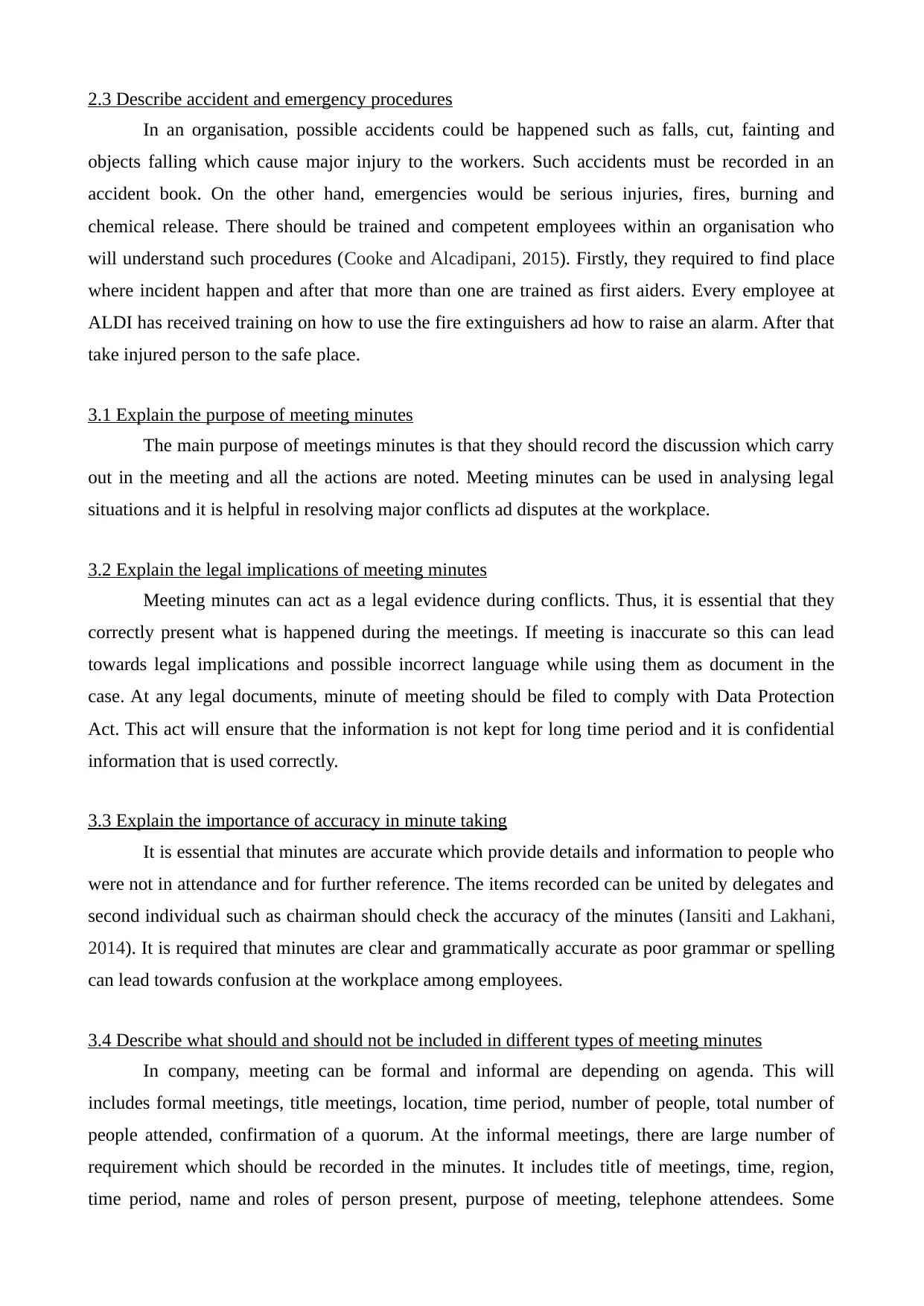
2.3 Describe accident and emergency procedures
In an organisation, possible accidents could be happened such as falls, cut, fainting and
objects falling which cause major injury to the workers. Such accidents must be recorded in an
accident book. On the other hand, emergencies would be serious injuries, fires, burning and
chemical release. There should be trained and competent employees within an organisation who
will understand such procedures (Cooke and Alcadipani, 2015). Firstly, they required to find place
where incident happen and after that more than one are trained as first aiders. Every employee at
ALDI has received training on how to use the fire extinguishers ad how to raise an alarm. After that
take injured person to the safe place.
3.1 Explain the purpose of meeting minutes
The main purpose of meetings minutes is that they should record the discussion which carry
out in the meeting and all the actions are noted. Meeting minutes can be used in analysing legal
situations and it is helpful in resolving major conflicts ad disputes at the workplace.
3.2 Explain the legal implications of meeting minutes
Meeting minutes can act as a legal evidence during conflicts. Thus, it is essential that they
correctly present what is happened during the meetings. If meeting is inaccurate so this can lead
towards legal implications and possible incorrect language while using them as document in the
case. At any legal documents, minute of meeting should be filed to comply with Data Protection
Act. This act will ensure that the information is not kept for long time period and it is confidential
information that is used correctly.
3.3 Explain the importance of accuracy in minute taking
It is essential that minutes are accurate which provide details and information to people who
were not in attendance and for further reference. The items recorded can be united by delegates and
second individual such as chairman should check the accuracy of the minutes (Iansiti and Lakhani,
2014). It is required that minutes are clear and grammatically accurate as poor grammar or spelling
can lead towards confusion at the workplace among employees.
3.4 Describe what should and should not be included in different types of meeting minutes
In company, meeting can be formal and informal are depending on agenda. This will
includes formal meetings, title meetings, location, time period, number of people, total number of
people attended, confirmation of a quorum. At the informal meetings, there are large number of
requirement which should be recorded in the minutes. It includes title of meetings, time, region,
time period, name and roles of person present, purpose of meeting, telephone attendees. Some
In an organisation, possible accidents could be happened such as falls, cut, fainting and
objects falling which cause major injury to the workers. Such accidents must be recorded in an
accident book. On the other hand, emergencies would be serious injuries, fires, burning and
chemical release. There should be trained and competent employees within an organisation who
will understand such procedures (Cooke and Alcadipani, 2015). Firstly, they required to find place
where incident happen and after that more than one are trained as first aiders. Every employee at
ALDI has received training on how to use the fire extinguishers ad how to raise an alarm. After that
take injured person to the safe place.
3.1 Explain the purpose of meeting minutes
The main purpose of meetings minutes is that they should record the discussion which carry
out in the meeting and all the actions are noted. Meeting minutes can be used in analysing legal
situations and it is helpful in resolving major conflicts ad disputes at the workplace.
3.2 Explain the legal implications of meeting minutes
Meeting minutes can act as a legal evidence during conflicts. Thus, it is essential that they
correctly present what is happened during the meetings. If meeting is inaccurate so this can lead
towards legal implications and possible incorrect language while using them as document in the
case. At any legal documents, minute of meeting should be filed to comply with Data Protection
Act. This act will ensure that the information is not kept for long time period and it is confidential
information that is used correctly.
3.3 Explain the importance of accuracy in minute taking
It is essential that minutes are accurate which provide details and information to people who
were not in attendance and for further reference. The items recorded can be united by delegates and
second individual such as chairman should check the accuracy of the minutes (Iansiti and Lakhani,
2014). It is required that minutes are clear and grammatically accurate as poor grammar or spelling
can lead towards confusion at the workplace among employees.
3.4 Describe what should and should not be included in different types of meeting minutes
In company, meeting can be formal and informal are depending on agenda. This will
includes formal meetings, title meetings, location, time period, number of people, total number of
people attended, confirmation of a quorum. At the informal meetings, there are large number of
requirement which should be recorded in the minutes. It includes title of meetings, time, region,
time period, name and roles of person present, purpose of meeting, telephone attendees. Some
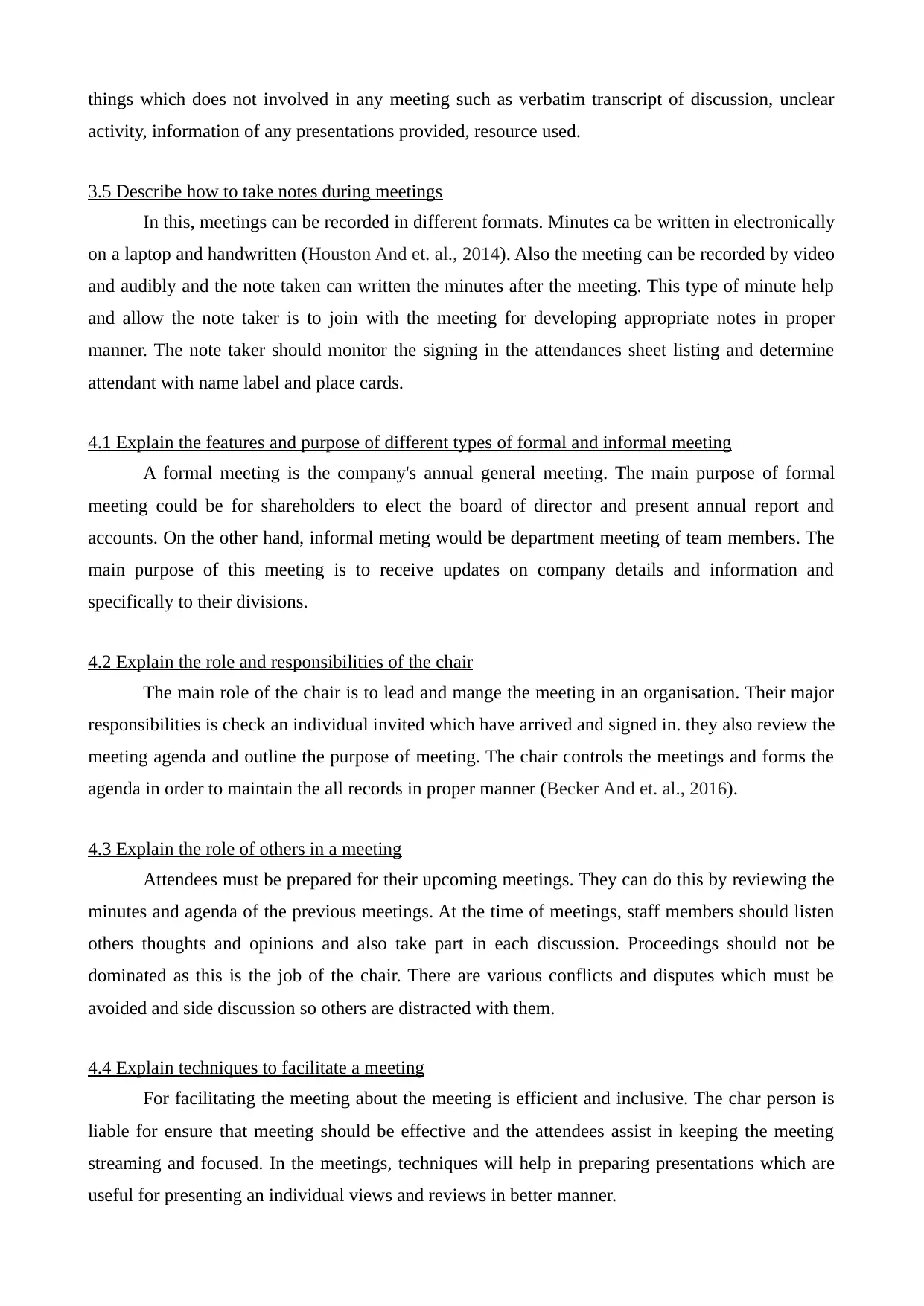
things which does not involved in any meeting such as verbatim transcript of discussion, unclear
activity, information of any presentations provided, resource used.
3.5 Describe how to take notes during meetings
In this, meetings can be recorded in different formats. Minutes ca be written in electronically
on a laptop and handwritten (Houston And et. al., 2014). Also the meeting can be recorded by video
and audibly and the note taken can written the minutes after the meeting. This type of minute help
and allow the note taker is to join with the meeting for developing appropriate notes in proper
manner. The note taker should monitor the signing in the attendances sheet listing and determine
attendant with name label and place cards.
4.1 Explain the features and purpose of different types of formal and informal meeting
A formal meeting is the company's annual general meeting. The main purpose of formal
meeting could be for shareholders to elect the board of director and present annual report and
accounts. On the other hand, informal meting would be department meeting of team members. The
main purpose of this meeting is to receive updates on company details and information and
specifically to their divisions.
4.2 Explain the role and responsibilities of the chair
The main role of the chair is to lead and mange the meeting in an organisation. Their major
responsibilities is check an individual invited which have arrived and signed in. they also review the
meeting agenda and outline the purpose of meeting. The chair controls the meetings and forms the
agenda in order to maintain the all records in proper manner (Becker And et. al., 2016).
4.3 Explain the role of others in a meeting
Attendees must be prepared for their upcoming meetings. They can do this by reviewing the
minutes and agenda of the previous meetings. At the time of meetings, staff members should listen
others thoughts and opinions and also take part in each discussion. Proceedings should not be
dominated as this is the job of the chair. There are various conflicts and disputes which must be
avoided and side discussion so others are distracted with them.
4.4 Explain techniques to facilitate a meeting
For facilitating the meeting about the meeting is efficient and inclusive. The char person is
liable for ensure that meeting should be effective and the attendees assist in keeping the meeting
streaming and focused. In the meetings, techniques will help in preparing presentations which are
useful for presenting an individual views and reviews in better manner.
activity, information of any presentations provided, resource used.
3.5 Describe how to take notes during meetings
In this, meetings can be recorded in different formats. Minutes ca be written in electronically
on a laptop and handwritten (Houston And et. al., 2014). Also the meeting can be recorded by video
and audibly and the note taken can written the minutes after the meeting. This type of minute help
and allow the note taker is to join with the meeting for developing appropriate notes in proper
manner. The note taker should monitor the signing in the attendances sheet listing and determine
attendant with name label and place cards.
4.1 Explain the features and purpose of different types of formal and informal meeting
A formal meeting is the company's annual general meeting. The main purpose of formal
meeting could be for shareholders to elect the board of director and present annual report and
accounts. On the other hand, informal meting would be department meeting of team members. The
main purpose of this meeting is to receive updates on company details and information and
specifically to their divisions.
4.2 Explain the role and responsibilities of the chair
The main role of the chair is to lead and mange the meeting in an organisation. Their major
responsibilities is check an individual invited which have arrived and signed in. they also review the
meeting agenda and outline the purpose of meeting. The chair controls the meetings and forms the
agenda in order to maintain the all records in proper manner (Becker And et. al., 2016).
4.3 Explain the role of others in a meeting
Attendees must be prepared for their upcoming meetings. They can do this by reviewing the
minutes and agenda of the previous meetings. At the time of meetings, staff members should listen
others thoughts and opinions and also take part in each discussion. Proceedings should not be
dominated as this is the job of the chair. There are various conflicts and disputes which must be
avoided and side discussion so others are distracted with them.
4.4 Explain techniques to facilitate a meeting
For facilitating the meeting about the meeting is efficient and inclusive. The char person is
liable for ensure that meeting should be effective and the attendees assist in keeping the meeting
streaming and focused. In the meetings, techniques will help in preparing presentations which are
useful for presenting an individual views and reviews in better manner.
⊘ This is a preview!⊘
Do you want full access?
Subscribe today to unlock all pages.

Trusted by 1+ million students worldwide
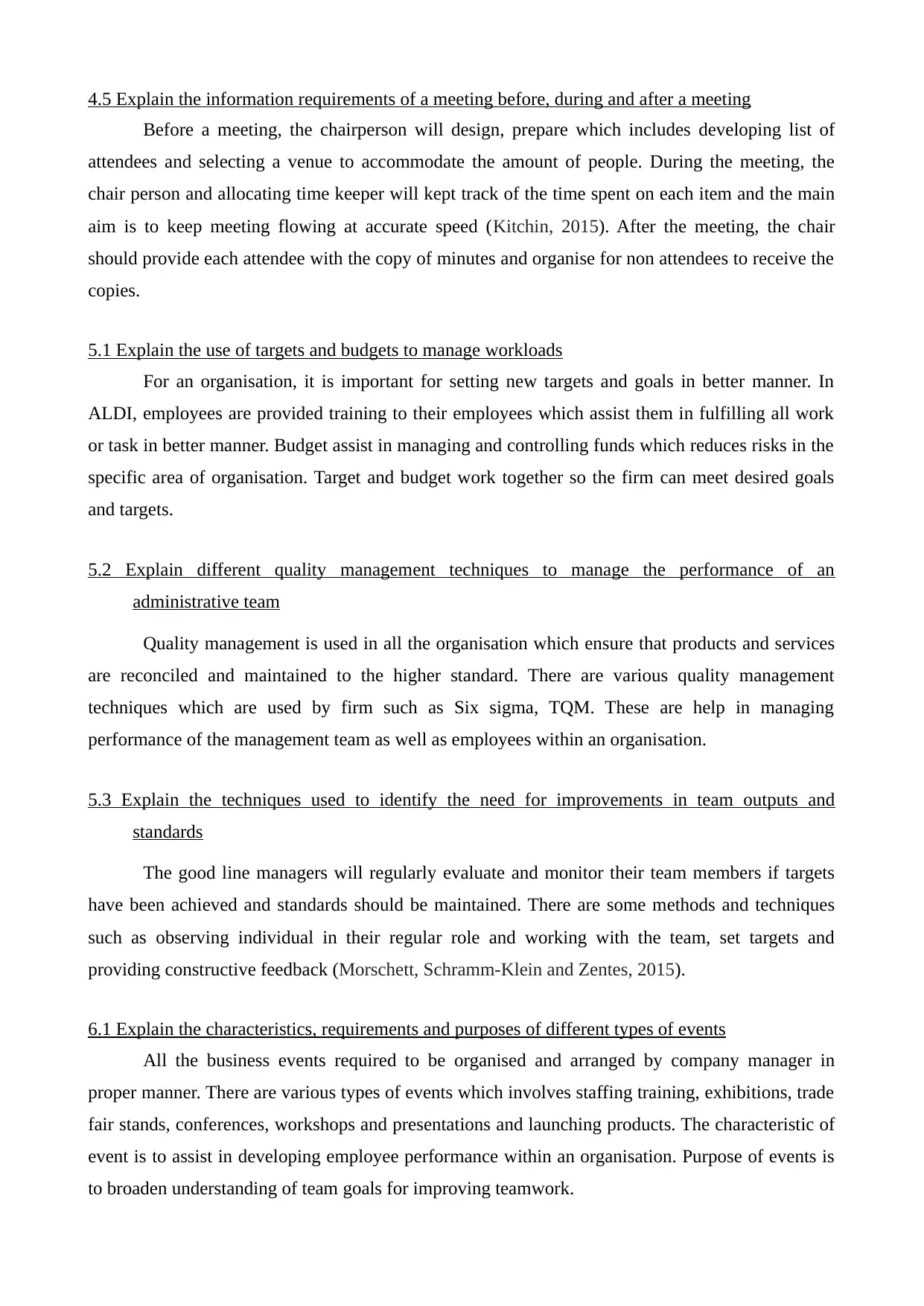
4.5 Explain the information requirements of a meeting before, during and after a meeting
Before a meeting, the chairperson will design, prepare which includes developing list of
attendees and selecting a venue to accommodate the amount of people. During the meeting, the
chair person and allocating time keeper will kept track of the time spent on each item and the main
aim is to keep meeting flowing at accurate speed (Kitchin, 2015). After the meeting, the chair
should provide each attendee with the copy of minutes and organise for non attendees to receive the
copies.
5.1 Explain the use of targets and budgets to manage workloads
For an organisation, it is important for setting new targets and goals in better manner. In
ALDI, employees are provided training to their employees which assist them in fulfilling all work
or task in better manner. Budget assist in managing and controlling funds which reduces risks in the
specific area of organisation. Target and budget work together so the firm can meet desired goals
and targets.
5.2 Explain different quality management techniques to manage the performance of an
administrative team
Quality management is used in all the organisation which ensure that products and services
are reconciled and maintained to the higher standard. There are various quality management
techniques which are used by firm such as Six sigma, TQM. These are help in managing
performance of the management team as well as employees within an organisation.
5.3 Explain the techniques used to identify the need for improvements in team outputs and
standards
The good line managers will regularly evaluate and monitor their team members if targets
have been achieved and standards should be maintained. There are some methods and techniques
such as observing individual in their regular role and working with the team, set targets and
providing constructive feedback (Morschett, Schramm-Klein and Zentes, 2015).
6.1 Explain the characteristics, requirements and purposes of different types of events
All the business events required to be organised and arranged by company manager in
proper manner. There are various types of events which involves staffing training, exhibitions, trade
fair stands, conferences, workshops and presentations and launching products. The characteristic of
event is to assist in developing employee performance within an organisation. Purpose of events is
to broaden understanding of team goals for improving teamwork.
Before a meeting, the chairperson will design, prepare which includes developing list of
attendees and selecting a venue to accommodate the amount of people. During the meeting, the
chair person and allocating time keeper will kept track of the time spent on each item and the main
aim is to keep meeting flowing at accurate speed (Kitchin, 2015). After the meeting, the chair
should provide each attendee with the copy of minutes and organise for non attendees to receive the
copies.
5.1 Explain the use of targets and budgets to manage workloads
For an organisation, it is important for setting new targets and goals in better manner. In
ALDI, employees are provided training to their employees which assist them in fulfilling all work
or task in better manner. Budget assist in managing and controlling funds which reduces risks in the
specific area of organisation. Target and budget work together so the firm can meet desired goals
and targets.
5.2 Explain different quality management techniques to manage the performance of an
administrative team
Quality management is used in all the organisation which ensure that products and services
are reconciled and maintained to the higher standard. There are various quality management
techniques which are used by firm such as Six sigma, TQM. These are help in managing
performance of the management team as well as employees within an organisation.
5.3 Explain the techniques used to identify the need for improvements in team outputs and
standards
The good line managers will regularly evaluate and monitor their team members if targets
have been achieved and standards should be maintained. There are some methods and techniques
such as observing individual in their regular role and working with the team, set targets and
providing constructive feedback (Morschett, Schramm-Klein and Zentes, 2015).
6.1 Explain the characteristics, requirements and purposes of different types of events
All the business events required to be organised and arranged by company manager in
proper manner. There are various types of events which involves staffing training, exhibitions, trade
fair stands, conferences, workshops and presentations and launching products. The characteristic of
event is to assist in developing employee performance within an organisation. Purpose of events is
to broaden understanding of team goals for improving teamwork.
Paraphrase This Document
Need a fresh take? Get an instant paraphrase of this document with our AI Paraphraser
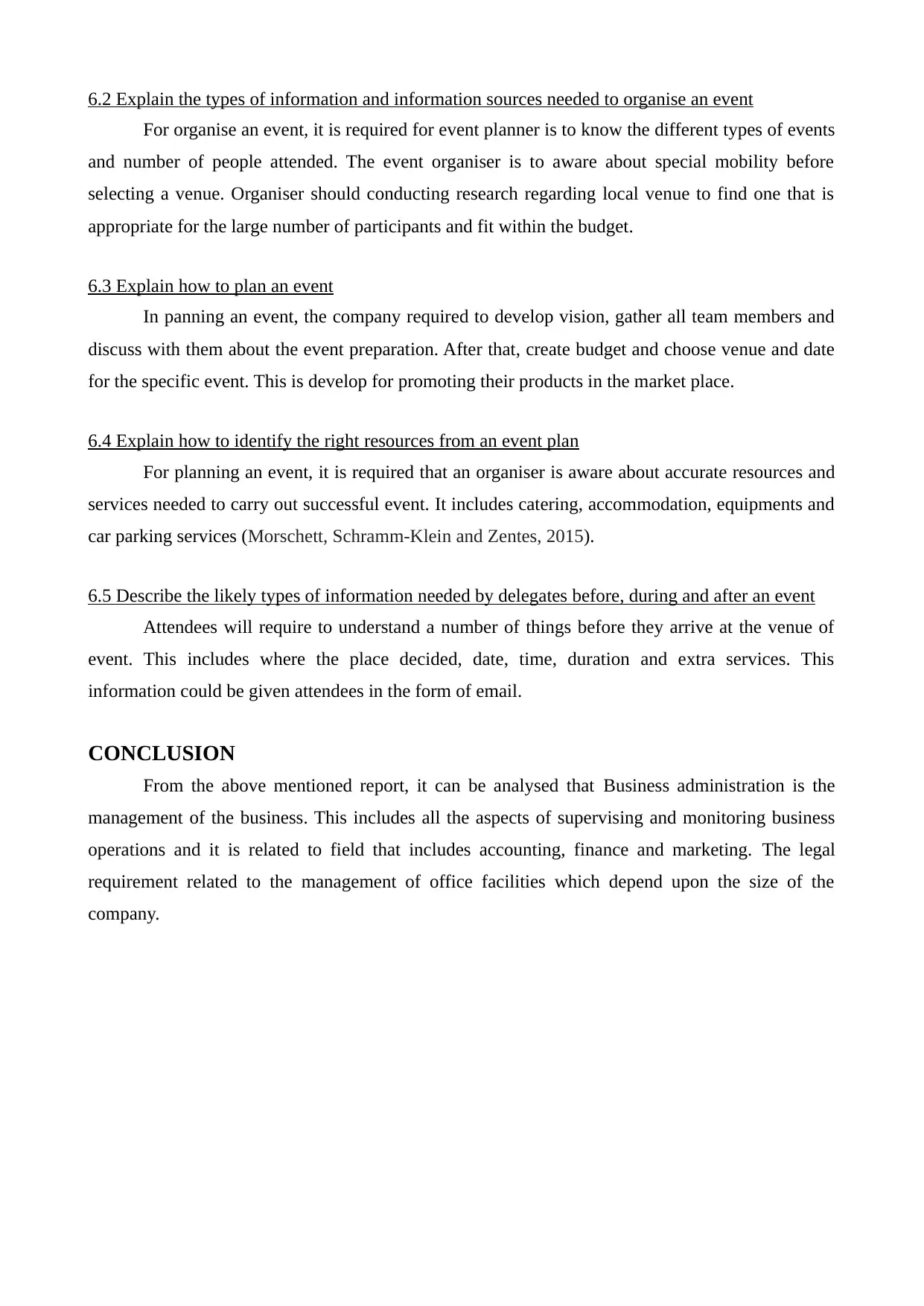
6.2 Explain the types of information and information sources needed to organise an event
For organise an event, it is required for event planner is to know the different types of events
and number of people attended. The event organiser is to aware about special mobility before
selecting a venue. Organiser should conducting research regarding local venue to find one that is
appropriate for the large number of participants and fit within the budget.
6.3 Explain how to plan an event
In panning an event, the company required to develop vision, gather all team members and
discuss with them about the event preparation. After that, create budget and choose venue and date
for the specific event. This is develop for promoting their products in the market place.
6.4 Explain how to identify the right resources from an event plan
For planning an event, it is required that an organiser is aware about accurate resources and
services needed to carry out successful event. It includes catering, accommodation, equipments and
car parking services (Morschett, Schramm-Klein and Zentes, 2015).
6.5 Describe the likely types of information needed by delegates before, during and after an event
Attendees will require to understand a number of things before they arrive at the venue of
event. This includes where the place decided, date, time, duration and extra services. This
information could be given attendees in the form of email.
CONCLUSION
From the above mentioned report, it can be analysed that Business administration is the
management of the business. This includes all the aspects of supervising and monitoring business
operations and it is related to field that includes accounting, finance and marketing. The legal
requirement related to the management of office facilities which depend upon the size of the
company.
For organise an event, it is required for event planner is to know the different types of events
and number of people attended. The event organiser is to aware about special mobility before
selecting a venue. Organiser should conducting research regarding local venue to find one that is
appropriate for the large number of participants and fit within the budget.
6.3 Explain how to plan an event
In panning an event, the company required to develop vision, gather all team members and
discuss with them about the event preparation. After that, create budget and choose venue and date
for the specific event. This is develop for promoting their products in the market place.
6.4 Explain how to identify the right resources from an event plan
For planning an event, it is required that an organiser is aware about accurate resources and
services needed to carry out successful event. It includes catering, accommodation, equipments and
car parking services (Morschett, Schramm-Klein and Zentes, 2015).
6.5 Describe the likely types of information needed by delegates before, during and after an event
Attendees will require to understand a number of things before they arrive at the venue of
event. This includes where the place decided, date, time, duration and extra services. This
information could be given attendees in the form of email.
CONCLUSION
From the above mentioned report, it can be analysed that Business administration is the
management of the business. This includes all the aspects of supervising and monitoring business
operations and it is related to field that includes accounting, finance and marketing. The legal
requirement related to the management of office facilities which depend upon the size of the
company.
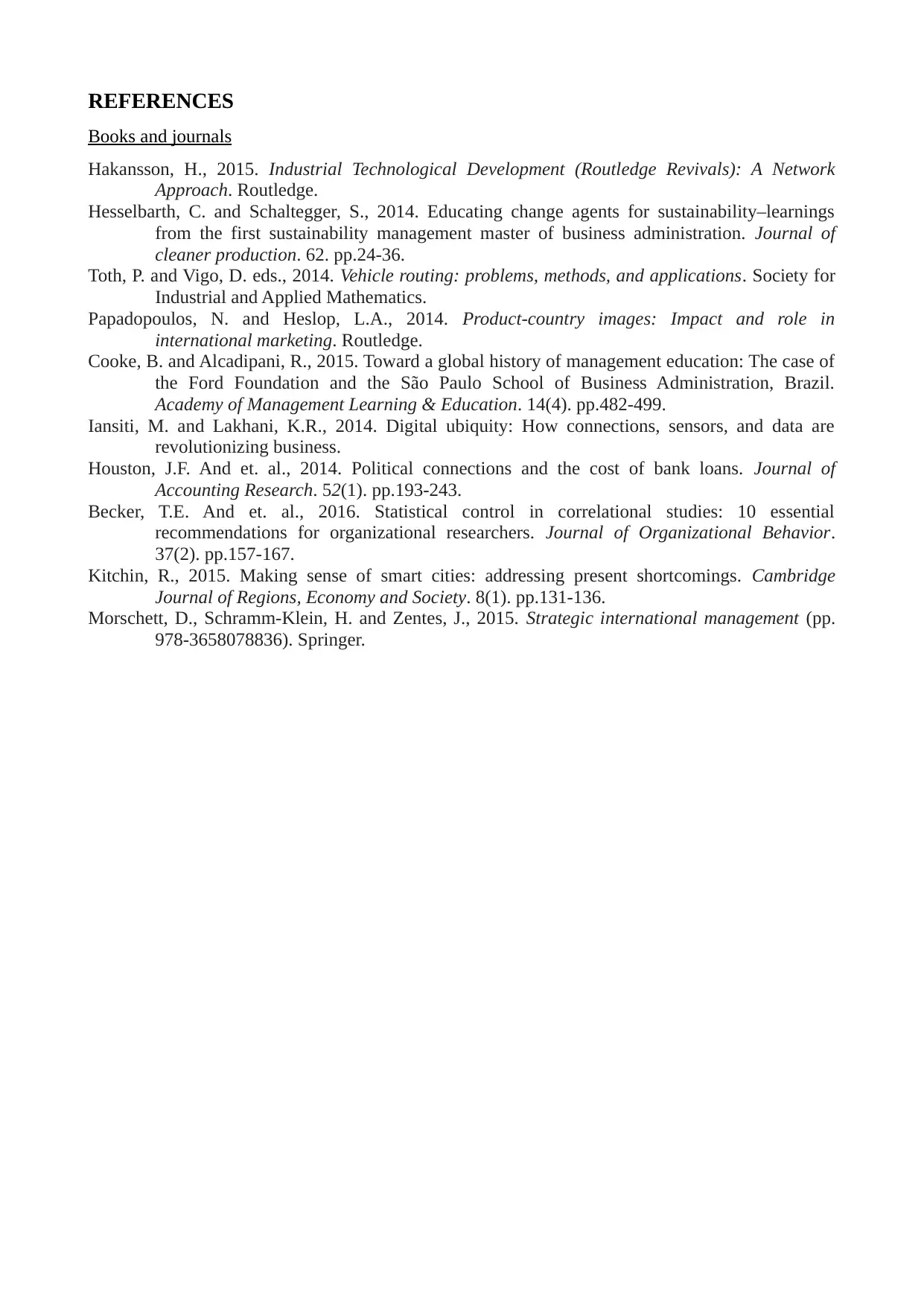
REFERENCES
Books and journals
Hakansson, H., 2015. Industrial Technological Development (Routledge Revivals): A Network
Approach. Routledge.
Hesselbarth, C. and Schaltegger, S., 2014. Educating change agents for sustainability–learnings
from the first sustainability management master of business administration. Journal of
cleaner production. 62. pp.24-36.
Toth, P. and Vigo, D. eds., 2014. Vehicle routing: problems, methods, and applications. Society for
Industrial and Applied Mathematics.
Papadopoulos, N. and Heslop, L.A., 2014. Product-country images: Impact and role in
international marketing. Routledge.
Cooke, B. and Alcadipani, R., 2015. Toward a global history of management education: The case of
the Ford Foundation and the São Paulo School of Business Administration, Brazil.
Academy of Management Learning & Education. 14(4). pp.482-499.
Iansiti, M. and Lakhani, K.R., 2014. Digital ubiquity: How connections, sensors, and data are
revolutionizing business.
Houston, J.F. And et. al., 2014. Political connections and the cost of bank loans. Journal of
Accounting Research. 52(1). pp.193-243.
Becker, T.E. And et. al., 2016. Statistical control in correlational studies: 10 essential
recommendations for organizational researchers. Journal of Organizational Behavior.
37(2). pp.157-167.
Kitchin, R., 2015. Making sense of smart cities: addressing present shortcomings. Cambridge
Journal of Regions, Economy and Society. 8(1). pp.131-136.
Morschett, D., Schramm-Klein, H. and Zentes, J., 2015. Strategic international management (pp.
978-3658078836). Springer.
Books and journals
Hakansson, H., 2015. Industrial Technological Development (Routledge Revivals): A Network
Approach. Routledge.
Hesselbarth, C. and Schaltegger, S., 2014. Educating change agents for sustainability–learnings
from the first sustainability management master of business administration. Journal of
cleaner production. 62. pp.24-36.
Toth, P. and Vigo, D. eds., 2014. Vehicle routing: problems, methods, and applications. Society for
Industrial and Applied Mathematics.
Papadopoulos, N. and Heslop, L.A., 2014. Product-country images: Impact and role in
international marketing. Routledge.
Cooke, B. and Alcadipani, R., 2015. Toward a global history of management education: The case of
the Ford Foundation and the São Paulo School of Business Administration, Brazil.
Academy of Management Learning & Education. 14(4). pp.482-499.
Iansiti, M. and Lakhani, K.R., 2014. Digital ubiquity: How connections, sensors, and data are
revolutionizing business.
Houston, J.F. And et. al., 2014. Political connections and the cost of bank loans. Journal of
Accounting Research. 52(1). pp.193-243.
Becker, T.E. And et. al., 2016. Statistical control in correlational studies: 10 essential
recommendations for organizational researchers. Journal of Organizational Behavior.
37(2). pp.157-167.
Kitchin, R., 2015. Making sense of smart cities: addressing present shortcomings. Cambridge
Journal of Regions, Economy and Society. 8(1). pp.131-136.
Morschett, D., Schramm-Klein, H. and Zentes, J., 2015. Strategic international management (pp.
978-3658078836). Springer.
⊘ This is a preview!⊘
Do you want full access?
Subscribe today to unlock all pages.

Trusted by 1+ million students worldwide
1 out of 9
Related Documents
Your All-in-One AI-Powered Toolkit for Academic Success.
+13062052269
info@desklib.com
Available 24*7 on WhatsApp / Email
![[object Object]](/_next/static/media/star-bottom.7253800d.svg)
Unlock your academic potential
Copyright © 2020–2025 A2Z Services. All Rights Reserved. Developed and managed by ZUCOL.




